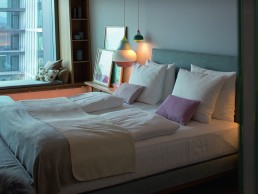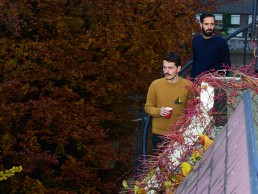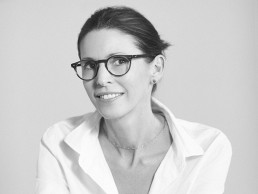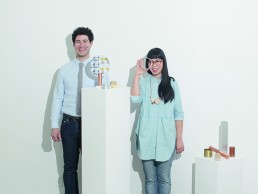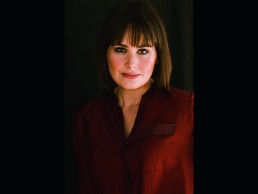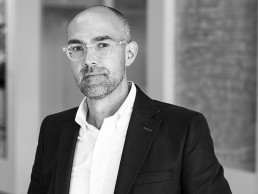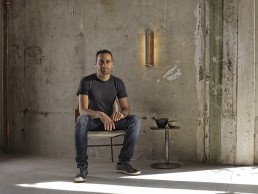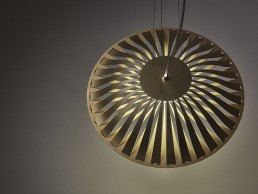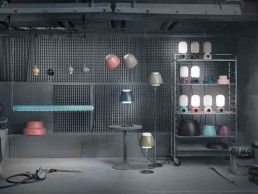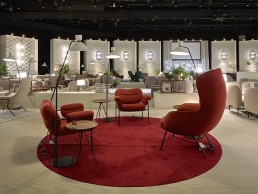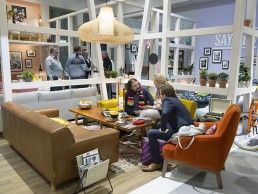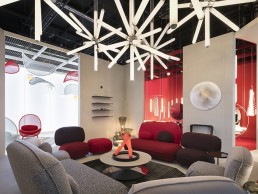Radisson Blu Frankfurt, Germany
Interior designers JOI-Design explore high-touch, high-tech hygge at the Radisson Blu Frankfurt.
Following their previous success creating two signature suites for the Radisson Blu Cologne, interior designers JOI-Design were again commissioned to partner on another exclusive design project, the creation of two high-style companion suites for the brand’s hotel in Frankfurt.
Working together with German design magazine Wohnidee, JOI-Design’s aim was to create one-of-a-kind hotel suites that would reflect the trends for individual style and residential comfort. Both 80sqm suites have a contemporary, residential feel and an elegant flair - conceived to show how two utterly different ‘on-trend’ design directions, one more traditionally recognised as feminine and the other more traditionally recognised as masculine, can indulge guests in high-touch, high-tech hygge.
The Modern Serenity suite is awash with powdery shades of pastel blue and antique pink. Soft forms and contemporary Nordic-style furnishings calm the mind and soothe the soul, while a plush sofa and wingback chair beckon guests to snuggle under a blanket with a book, or soak up the thrill of the Frankfurt skyline through full-height glazing. Flooded with natural light, the suite is an ideal nook for working from window seats stretching the width of the rooms. For the decorative lighting elements, JOI-Design chose to use a mixture of pendants, floor and table lamps from various lighting brands including Louis Poulsen; Brokis and Le Klint to add a deeper level of sophistication to the suite.
The Classic Monochrome suite has a ‘handsome’ feel suggestive of a well-appointed haberdashery within an urban loft. Architectural forms and beautifully grained timber combine in furnishings such as the writing desk and its moulded chair. As an expression of precision tailoring in its finest form, carefully proportioned patterns like plaid, houndstooth, herringbone and woven linen adorn the chaise lounge, sofa, headboard, rug and floor. Faux fur fabrics and a curvaceous pendant light above the dining table offer a counterpoint that softens the serious ‘suit fabric’ palette of tobacco, cognac, navy and charcoal. The decorative lighting elements in this suite come in much more monochromatic tones and are supplied again by the likes of Le Klint, Louis Poulsen, Brokis and Gubi, to name just a few.
“We were truly lucky that our client, Radisson Blu, trusted us to meet their expectations and provide something ‘out of the box’,” JOI-Design’s Peter Joehnk tells darc. “They were quite open-minded, even when we expected to face concerns about practicalities, they either didn’t challenge us and if they did have questions, they were minimal. For example, our wall-mounted newspaper holders were accepted – even though there was a risk that ink and hands would smudge the wall and need to be cleaned and repainted more frequently.
“As the suites were integrated within an existing building, our aim was to change as few electrical points as possible, which meant our designs included several decorative lamps whose plugs could be connected to existing sockets. Having individual, free-standing fixtures also helped us achieve the personalised home-like cosiness we envisioned for our concepts. In this specific case, we were responsible for the lighting design, where as we would normally work with a lighting designer.
“Our primary focus was to choose state-of-the-art light fixtures whose modern, individual designs would help the rooms feel more like comfortable private residences versus conventional hotel suites. We treated the lamps as decorative features that helped bring our overall vision for the design to life. Our focus for the suites was to create a highly specialised design that truly came from our imaginations and with very little client influence.
“Usually we present our design concept and then a debate follows in which we make compromises – not only for practical and functional reasons – but also for the personal tastes of other people who can’t differentiate a hotel guest’s specific requirements and what they want for living rooms in their own homes.
“I would be a bad designer if I said there wasn't room for improvement. but overall I am happy with the results - the final atmosphere is exactly what we set out to achieve.”
Simone Farresin & Andrea Trimarchi
Amsterdam’s Simone Farresin and Andrea Trimarchi of Formafantasma use basic principles to give new shape to light. darc sat down with the pair to talk about the past, present, and their big plans for the future.
“What I love about light is that it’s intangible,” says Simone Farresin of Amsterdam-based design practice Formafantasma. “Light can have such a tremendous impact on a space. Designing an object for it is interesting because it’s not really about the form of the object, but about the feeling light can create.” Fascinated with objects and the ideas they convey, Farresin founded Formafantasma, together with partner Andrea Trimarchi, in 2009 after graduating from Design Academy Eindhoven, in the Netherlands. Originally from Italy, Trimarchi and Farresin are paving the way for a new generation of philosophical designers. Their thought-provoking creations, often exhibited as humble experiments, or ‘tests’, expose the nature of things, prompting us, the collective viewer, to consider both our past and our future. From their studio in Amsterdam’s Noord district, the pair speak with poetry and passion about design and the need for progress in the field.
“I discovered design at an early age, it was something that I was always fascinated by,” Farresin tells me one early morning in January. “It was a bit different for me,” says Trimarchi, from across the table. “I come from the south of Italy, from Sicily, where there isn’t much of an interest in design,” he explains. Indeed, design schools in Sicily are extremely sparse. To study the subject, most travel north or move abroad. “There is this idea that design is only in the north, which is crazy” he adds. Out of what felt like necessity, Trimarchi left his hometown of Caltagirone to study architecture at the Istituto Superiore per le Industrie Artistiche in Florence. It would be here, amidst the masterpieces of Renaissance art, literature and culture, that the two would eventually meet.
The pair started working together, albeit on minor projects, almost immediately. “It was mostly for fun, something we did next to our studies”, explains Trimarchi. “We weren’t interested in design in the beginning, we were doing mostly graphic stuff,” adds Farresin. An affinity for design, and specifically product design, grew gradually over time, as the two got to know one another. “We’re a couple, so it happened very organically” explains Farresin. Hours outside of class was spent mostly at gallery openings and exhibitions. These early excursions proved to be profoundly formative, prompting their first dialogues about design. “We didn’t really realise we were talking about design at the time,” he says, adding that “it was through these talks that we began to see that we had a similar way of looking at the world.”
Conversation continues to play a major role both in their relationship and in their work, so much so that it’s become an integral part of the studio’s design process. “Our way of working is about discussion,” says Farresin, “it comes from words,” he adds. He explains how having shared goals and values as designers keeps them in tune, even when their opinions seem out of sync. “We can understand each other very intuitively, which helps us a lot” he says. “We never have dramatic discussions about the direction of something. The struggles we face are the usual struggles of the creative process.”
With undergraduate degrees now in hand, the pair set out to explore new design terrains, outside of their native Italy. They applied with a single portfolio to Design Academy Eindhoven in the Netherlands, and much to their delight, were soon ready to enrol. “Crazily enough, we were accepted as a duo form the very beginning,” says Trimarchi. Formafantasma, which is a combination of the Italian words forma (form) and fantasma (ghost), was a name that the two concocted while still in Florence. “We chose the name really early on,” says Farresin. “The idea was totally different back then. The idea was that it’s the process that informs the form, and not the other way around, meaning that the form can change. Our work is formalised carefully, but it’s not about form. The name is pointing to that,” he explains.
To the design industry today, the name Since establishing the studio in 2009, Trimarchi, 34, and Farresin, 37, have swiftly set themselves apart with their thoughtful and eloquent creations. More than makers of beautiful things, they are provocateurs, poets, philosophers, and dare I say it, idealists. The pioneers of a modern humanist ethos, they seamlessly fuse past with present, anthropology with art, and in so doing, set the precedent for a more honest and holistic discourse around the subject of design. They do not shy away from the past, but instead embrace our collective human history as a tool for shaping progress.
“Design as a discipline is in a very peculiar spot in a chain of different elements, from economy, to politics, to social science, to the everyday,” explains Farresin. “We’re interested in that chain, and how objects in their particularity connect all these things together.” Fuelled by their seemingly boundless curiosity, Farresin and Trimarchi approach each new project from an analytical standpoint, stripping down everyday objects to their most essential elements, or truths. To do so, Formafantasma morphs into a creative chameleon, masterfully assuming the role of artisan, archeologist, botanist, historian, humanitarian, physicist, and more. They are the Renaissance Men of our time.
As young graduates determined to make a career in design, Farresin and Trimarchi saw little space for a future in Italy. “We come from a country where young people are not really considered,” says Trimarchi. “Seeing the graduation show at the Academy and how students here are given such an amazing platform was exciting for us, it opened up our eyes. We unconsciously knew it was our only chance if we wanted to do something in this field.”
Farresin agrees: “Eindhoven is so different from Florence. It’s a place without history, which was very liberating for us. A lot of what we do as designers is very thought through, but it’s also very instinctive. Our instinct was telling us to go there.” If life has taught me anything over the years, it’s that you should always go with your gut. Good things typically follow.
“We first started thinking about light six years ago, around the time we presented Botanica,” explains Trimarchi. Exhibited for the first time in 2011 at Spazio Rossana Orlandi in Milan, Botanica is a poetic study of natural polymers and plastics. The collection, which features a family of sculptural vessels, and has nothing to do with lighting, captured the imagination of local artist and filmmaker Francesco Vezzoli, who, as it turns out, is also a close friend of Piero Gandini, CEO of Flos. “He came to see our exhibition, and was determined to put us in touch with Piero.” Before they knew it, they were sitting at the Flos headquarters talking design and light with Piero himself. The meeting didn’t go quite as planned, however. “We weren’t ready,” confesses Trimarchi. “We went there without a product, just with ideas. We realised that it wasn’t the right moment for us. We were still in the process of shaping our own perspectives about design, and needed more time to investigate.”
Formafantasma spent the next few years developing their craft, all the while enchanting us in the process. Lighting remained on their radar, and in 2016 the pair presented their first experiments with light as part of a broader collection called Delta. A collaboration with Rome’s Stagetti Galleria O. Roma, Delta is the fruit of the gallery’s annual Privato Romano Interno programme. Each year, the gallery commissions international designers to create a collection of furniture pieces using the Eternal City as muse. As part of their research for the project, the pair travelled to the capital as full-time tourists. They visited nearly every museum and archeological site in Rome, documenting every detail and object along the way. “We found the light in Rome to be very peculiar and interesting,” says Farresin. “So, we thought, why not use this time to think about lighting? We started developing the body of work that is now Delta, and in the meantime also began experimenting with elements of light.”
Drawing references from the rituals and ruins of ancient Rome, Delta is an elegant exercise of abstraction. Formafantasma reinterprets Roman architecture and artefacts and reduces them to their simplest and purest forms. Composed of two discs suspended by gilded guitar strings, the Eclipse lamp models the skylight of the Pantheon, while another lamp, aptly titled Helmet, recalls the shape of a centurion’s headgear. The Magnifier, Reflector and Radar lamps take a slightly more scientific approach, and instead make use of mathematics and materials to reflect and refract light. Employing natural materials endemic to Rome, such as porcelain, travertine, wood and bronze, Delta makes the old and seemingly mundane shine anew with a fresh modern aesthetic.
“We really like indirect lighting,” says Farresin. “Almost all the lights we’ve done are reflecting off other surfaces and things.” Anno Tropico, which the duo presented in 2016 at a solo exhibition held by the Peep-Hole Art Centre in Milan, is a masterful investigation into the material quality of indirect light. Relying on as little material as possible, each ‘test’ looks at light from a specific perspective. Sculptural pieces made with dichroic glass, optical lenses and parabolic mirrors, bend and redirect the passage of light, casting shadows and projecting shapes and colours across what would otherwise appear to be plain surfaces. “The construction of the lights is very simple,” explain Trimarchi, adding that “it’s not so much about the object’s design, as what effect light can have in space.”
At last year’s Salone del Mobile, Formafantasma inaugurated the reopening of the historic gallery Spazio Krizia in Milan with a retrospective exhibition called Foundation. “We wanted to first call the project Formation, but it reminded us too much of the Beyonce song, which we love,” confesses Farresin, with a chuckle. Dedicated solely to the study of light, the exhibition displayed pieces from both Delta and Anno Tropico. Mixed in with the old were also a few novelties, including a preview for designs being created in collaboration with Tilburg’s TextielMuseum. Also on show in Milan were prototypes for what will be Formafantasma’s first industrially produced lights, for — you guessed it — Flos. Blush Lamp, an adaptation of colour tests created for Anno Tropico, and WireLamp, a circular wall sconce entailing just a ring of light and a cable, are scheduled for release later this spring.
Next to running their design practice, Farresin and Trimarchi teach, travelling once a week from Amsterdam to Eindhoven to run courses at their alma mater, DAE. In 2016 Formafantasma joined the Rosario Gagliardi Academy of Fine Arts in Siracusa, located in Sicily, as co-heads of the bachelor of design programme MADE. “It’s a challenge to do both, teaching and working. It can easily become too much” confesses Farresin. As with their studio work, the duo approaches education from a design standpoint. Farresin explains: “Education is a very interesting field, in fact, we’re more interested in education than in teaching. In Sicily, we have an opportunity to design education, to build a course. We’re deciding what to study, as well as when and how. In that sense it’s much closer to design.”
After all, designing ideas is Formafantasma’s forte. Given that they’re still at the start of their career, Formafantasma has accomplished a great deal in almost next to no time. Just shy of their ten year anniversary as a studio, the pair has a lot to think about this year. “2018 will be a year for understanding and reflection” says Trimarchi. “It’s an important moment for us to think about what we’re actually interested in” adds Farresin. Like the studio, the future may also come as a pair: “We’re considering the possibility of having two studios, one experimental and the other commercial,” explains Trimarchi. “Sometimes it’s difficult for people to understand what we do, because we do a bit of everything: interiors, fashion shows, products, exhibitions. Right now everything is on the same level. We care a lot about the experimental work we do, and we’d like to highlight that more.”
While the shape the studio will take in the future is still to be seen, what Trimarchi and Farresin know for sure is that they want their designs to make a difference. “The design industry is completely disconnected with reality,” says Farresin. “Other industries such as fashion have done some interesting things in terms of sustainability, but the furniture industry is still behind.” Trimarchi is on the same wavelength: “Sure, we can design a nice object for a company, but what if we can help in other ways? I think that’s how we feel we can make an impact on the industry, to bring a more holistic view on things, to advise companies on how to be more sustainable and efficient, from materials to manufacturing. That’s where I see a potential for change.”
Lindsey Adelman
In celebration of International Women’s Day, Helen Ankers spoke exclusively to one of the leading ladies of light, Lindsey Adelman about her influences and career to date.
Since the start of her career in 1996, New York native, Lindsey Adelman, has been considered one of the leading ladies of light. After founding her own studio in 2006, she has expanded to over 40 employees and to this day continues to be both challenged and fascinated by the elusive quality of light. In celebration of International Women’s Day on March 8, darc spoke exclusively to Adelman about her career to date, her influences and current trends in lighting.
Growing up in the suburbs of New York, Adelman’s exposure to art and design was limited to her Marimekko bed sheets and knowing who artist Morris Lewis was and so, the idea of working in industrial design didn’t come until much later.
“I wasn’t really aware of designers growing up,” says Adelman. “It was the 70’s and there weren’t that many compared to today – now in New York it seems everyone is a designer. When I was younger, I knew what an artist was and so I thought that’s what I would be when I grew up.”
Influenced in many ways by her friends and family, Adelman tells darc how her best friend’s unconventional home life had a strong influence on her: “Her dad was an art dealer and there were a lot of Morris Lewis paintings in their home and I think that unconventional home life and career influenced me in a way that I’m not fully conscious of… I think that by osmosis, it affected me. They had about six dogs, snakes and guinea pigs and my home life was very different - everything was very neat and tidy and we were expected to be well behaved and quiet.
“From a design perspective, my mom was an interior decorator, so I understood the industry a little bit. She would go to the D&D building (Decoration and Design building) in Manhattan and come home with fabric samples. I had an idea of what that meant, so I think that exposure was also really informative.
“I didn’t really know much about industrial design until after my English Literature degree. I thought it sounded like such an interesting career because it was similar to sculpture but more employable and I thought it would be a much more predictable way to make a living. I liked that I could interact with an audience compared with being an artist, which felt much more risky and lonely.”
After realising her passion for industrial design, Adelman applied to the Rhode Island School of Design in her 20’s, where she studied industrial design and found herself influenced by designers such as Ingo Maurer and his idea of using light and matter. After graduating Adelman moved to Seattle with her now husband where she started her career in lighting before moving back to New York to begin working with notable designer David Weeks.
“We founded a company together called ‘Butter’, which did really simple origami inspired light fixtures,” she continues. “They were really affordable so it was great for us in terms of exposure. We got to a place where we were going to have to start manufacturing overseas to make a living and we didn’t want to do that so we closed the company.”
It was at this point in her career that Adelman made the decision to take a step back from the industry and start a family. “I had my son in 2004 and didn’t work for a couple of years,” she says. “I was really doubting if I wanted to stay in design at that time because I wasn’t really enamoured with the industry and I was motivated by competition, which felt really unhealthy. I wanted my work to come from a much purer place.
“When I re-entered the industry with my own studio, I kept my intentions in check, honoured my ideas, was doing my best work and didn’t rush. I wasn’t putting a lot of work out there just because I could… It was really about whether I could quality check everything and I ask myself, ‘Can I really be good to my clients?’, I didn’t want to get ahead of myself and go too fast.”
By taking time out and disconnecting from the industry, Adelman was able to develop a new perspective on lighting and design. “It’s so good to constantly step back and ask questions,” she says. “Why does it have to be this way? How else could it be? How do I want to live my life? How do I want my design experience to be? What am I curious about? It’s always really good to question that stuff and even if you don’t know how you can change it, just know that you want to change it.”
For Adelman, lighting has always been her chosen form of design, enabling her to combine her interest of quantum physics and mechanics with her passion for creating innovative pieces by experimenting with different materials and form.
“When I was starting out, I saw so much possibility to invent something that I hadn’t seen before in lighting and that was the draw. I’m able to dream bigger now… I’m still challenged by the elusive quality of lighting - grains of light, particles vibrating faster than the thing that’s holding it. When you’re working with something like glass as a light fixture, it’s about how that reflects and refracts the light. You’re looking at this immaterial substance, how to place it and the idea that one fixture places points of light and kind of reinvents the formula to get it there. I find it endlessly creative.
“Light affects the quality of life in the room and I’m deeply and emotionally affected by light without a doubt. I find that I am emotionally depressed in a room that feels like a hospital or an office, it doesn’t matter what the room is. My favourite light comes from candles – they are definitely the most magical.”
Having worked in lighting design for more than two decades, Adelman has observed many reoccurring trends, telling darc: “A lot of lighting looks as though it’s influenced by a handful of designers. I love the work of Michael Anastassiades; the standards he sets for himself are so high and his original collections are so masterful, that we see so many people trying to emulate that work. And they can’t get it… they’ll never get it. They’re not topping what he’s doing - they’re not going to top what he does. As well as this, an emerging designer that I get to work with every day and love, is Mary Wallis. I love the tragic beauty and a feeling of self-destructive diva drama in her work.”
Adelman also insists that lighting design isn’t always as straight forward as it seems and that designers should spend more time discovering their own voice. “I think when people look at a light they think ‘that doesn’t look hard, I could become a lighting designer’ and they try and they do, but I think all of these designers have the potential of really discovering their own voice, thinking about their original authenticity and what they want to bring to this world of lighting.
“Even after 20 years, my work is still really challenging me and I still have ideas that I can’t nail yet. I still haven’t got exactly what I want yet and this is probably true for all designers.”
When asked about her experience as a woman working within the world of design, Adelman reveals her experience has been nothing but positive and in some cases has even worked to her advantage, saying: “It’s a terrible thing to say but I think if anything it’s helped me... there’s been times where I know a curator might have a handful of male designers and I’ve been picked because they need a female designer as well!
“The statistics that you see about fewer women heading up design companies comes down to this… and it may be controversial to say, it may not… but I believe it’s true that women are still the ones who are primarily raising children and there are a lot of women out there who want to raise children. I look at my fourteen-year-old and I see my role as raising a leader of the future - that’s my priority.
“In my career I’m not looking for accolades or external accomplishments, I’m not under the illusion that around the next corner there’s going to be something to improve my quality of life because that happens when I’m experimenting and being hands on with materials... collaborating with different artisans and having a breakthrough moment in the process.
“You can’t ‘job out’ motherhood. There are lots of things you pass on because you want to be at home in the evenings, you don’t want to travel as much… It’s hard work being a mom and a wife but I want to spend my time doing it and it’s deeply satisfying and I know that I would regret it if it were different. I think that’s one of the reasons there aren’t as many women heading up companies, but they’re affecting leadership on a much deeper level by being mothers.”
In terms of a ‘design eye’ and how men and women differ in the workplace, for Adelman she sees that men and women do have different design approaches and the way in which they experience light.
“I read some really interesting articles about how women experience light differently to men,” she says. “It said women are more sensitive to the spectrum of light and I’ve experienced that personally… My comments about light quality are completely different to a man talking about the same light in the same room. I find women are also motivated by different factors, there’s a tonne of community and collaboration among women. The process is more subtle and more of a spiral rather than a line.”
In terms of notable projects, while for the outside world looking in, there have been many, for Adelman it’s about what’s next, rather than what’s been before: “I’m working out of my home studio looking up at this mobile light… It’s a prototype piece and I would say this is the one this is the stand out moment, because I haven’t made the next one yet… I’m always thinking about the next piece and about work in progress. I don’t have a relationship with work that’s finished.”
Continuing to look ahead, one of Adelman’s next launches will be at Salone del Mobile in Milan in April. Sharing a space with Calico Wallpaper, the designer will launch the lighting system Drop, which can be specified by interior designers and architects for different feelings or rooms. “It can be very minimal for one configuration or it can feel super over the top and elaborate but using the same system,” she says. “It took a while to figure out so I’m super excited to launch it.”
Constantly engrossed with her next project and always forward-thinking, Adelman will continue to inspire the men and women of design, constantly pushing boundaries through experimentation and innovative use of light.
Ladies & Gentlemen Studio
Jean Lee and Dylan Davis bring a balanced approach to product design, considering at all times a person’s connection with the object. Helen Ankers takes a closer look at their work with light.
Ladies & Gentlemen Studio is a multi-faceted design studio based in Brooklyn’s Red Hook neighbourhood. Founded in 2010 by designers Jean Lee and Dylan Davis, their aesthetic and design philosophy embraces complementary opposites with an unexpected balance of warm minimalism, playful austerity and simple sophistication. Blending resourceful curiousity with the desire to celebrate materials and functionality, the duo’s open approach to design yields an ever-evolving set of ideas and experiments collected from everyday discoveries, explorations and surroundings.
“It’s all about balance for us,” Davis tells darc. “Whatever we’re working on, we’re always exploring forms, ideas and materials and working out the best angle to express exploration in the most simple and pure form.”
“We tend to be inspired by movements with historical context or cultures rather than fleeting trends,” adds Lee, “and designs that evoke the most emotion or personality, which naturally trickles down into our own practice.”
Having started their journey together at the University of Washington, the duo met while studying industrial design; and as with most designers, the need to be creative, to ‘play’, and to experiment is something that has been ingrained in Davis and Lee from an early age. “I’ve always been really interested in art and cars and when I was a kid I wanted to be a car designer,” Davis says. “I would endlessly sketch all these cars that were ridiculous of course, but that was the moment that I remember being really interested in design and this evolved over time. My mom always wanted me to be an architect and both my grandpa and father built their own homes, which is pretty cool. I’m from Michigan and there’s a real attitude of making things and being industrious and it’s definitely rubbed off on me. If you want to make something you figure it out yourself and just get on and do it – you learn from the process. My dad was a bit of a hippy and built his house around a chicken coop, he kept adding little additions – I really admire his attitude towards it and I try and take that on board in my own design process.” And for Lee, it was actually her dad who pointed her in the direction of industrial design. “I was always interested in making things and being hands on,” she says. “And was always very into crafts and things like that but it was my dad who, when I was in high school, actually pointed out I could do something in industrial design… it wasn’t something I had explored but once I did, realised product design can provide a good balance of creativity while creating something useful and tactile.
“I think one of the big turning points for us was going to Italy as part of our course… it was a glimpse into what could be. There were all these artistic influences; people living their taking pride in having an item custom made; and for us to realise you could make a living out of designing and making your own products was refreshing.
“At that time in Seattle it was mostly corporate work… people would be applying for jobs under a bigger brand name or the designs were more about technology and we weren’t relating to it at all. Italy was an eye-opening experience – seeing the shops and studios working and selling, it was very inspiring.”
With other artistic influences coming in the form of mid-century Modernists, expressive 70’s Italian designers, and humorous Dutch designers, the pair find themselves most struck by designs that evoke a sense of emotional connection, which trickles down into their in their own practice to create functional, thoughtful objects with a sense of wonderment.
“A bit of playfulness always comes from within,” continues Lee. “While we explore and play around with the materials – we like to elevate the materials to the next level and I think the way in which we balance all of these different ideas gives our designs a level of unexpectedness.”
“The first light fixture we designed is a pretty good example of our approach,” adds Davis. “The Aura light was born from some metal rings we had lying around the studio… we discovered that when we held them up to the light a sort of simple, magical effect happened when the light reflected off the ring and from there a discussion began.”
The Aura fixture sees Davis and Lee pare down light into its two elemental ingredients – the source and its illumination (highlighted by a brass ring). The resulting pendant light is simple and versatile with the two available sizes looking just as striking hung individually at adjustable heights or in clusters and rows.
“Our explorations from there have gone in many different directions,” says Davis. “But we try to have a really elemental curiosity that drives the concept for each design.”
“For example, with the Shape Up lighting fixture we challenged the concept of a traditional chandelier,” adds Lee. “It was more about how we could create a new architecture… we were trying to create something playful yet elevated. This chandelier in particular was inspired by some jewellery pieces we had designed the year before; it was about these elemental shapes hanging asymmetrically. Lighting in some ways is like jewellery for the space, it’s like the statement piece that often brings the space together and creates an expressive element to it so we imagined the piece that way, we really enjoy having that flexibility.”
“That’s why it’s so important to us not to focus on one product type,” continues Davis. “In the studio we’re always moving from highly functional small objects to completely non-functional sculptures – it’s very important to us to always explore these different methods because they all inform each other.”
This considered approach soon attracted the attention of the design world, specifically Jason Miller, fellow product designer and owner of New York-based lighting brand Roll & Hill. And it wasn’t long before the two studios collaborated to produce lighting collections Shape Up and Kazimir.
“Jason first saw our work during New York Design Week in 2013,” says Davis. “But it took about another eighteen months before we landed on something workable for them. Looking back, at that point the work we were presenting was still quite unrefined and we’re still surprised now that he saw something in us back then… it really is a testament to his ability in seeing something in someone.”
“We kept producing all these ideas that we thought would be good for Roll & Hill but weren’t quite right and in the end he said to us ‘I asked you guys to design a fixture because I want a Ladies & Gentlemen fixture, not a Ladies & Gentlemen for Roll & Hill fixture’, that was the big turning point for us creatively,” adds Lee. “I don’t think we had the confidence to think of ourselves in that way at that point – offering our vision rather than just working to their vision. That moment was definitely a bit of a milestone for us, both personally and creatively.
“Jason was pushing us and wanting our design perspective on something and that was really refreshing – some companies you encounter might try and steer you to what fits within their company, but the way Jason worked with us was different – he trusted us a lot and wanted us to be more true to how we design.”
Shape Up is a versatile lighting series in celebration of geometric shapes and materials. The playful collages upend traditional notions of symmetry in favour of a dynamic spatial harmony. The collection’s abstracted lampshade forms are networked via connecting cords and hubs. The resulting modular system allows the shapes to be suspended and composed indefinitely in response to a space’s architecture and function. As if connecting the dots, the cord network graphically expresses the light source’s formal and electrical connection to each other.
The Kazimir collection was inspired by the late 1800 Russian artist Kazimir Malevich who created paintings often composed of flat, abstract areas of multi-layered shapes and compositions. The fixtures are the result of Ladies & Gentlemen’s increased experimentation with ‘complexity and layering’ and their interest in geometric abstraction and minimalism. Kazimir explores an ‘elemental complexity’ through a three-piece collage of textured and dichroic plate glass shapes arranged around an illuminated triangular frame to create new optical dimensions and effects. Individually, each pane is an unexceptional shape, but collectively composed they create fascinating effects that vary from each angle and lighting condition. The resulting arrangement celebrates layering of shape, texture, colour, and effect.‘Complexity’ lies at the intersection of the three elemental forms and invites one to interact with the piece by walking around it and see how the shapes and composition transforms.
Outside of their collaboration with Roll & Hill, Lee and Davis have been working on a lighting fixture launched last year called Float. More sculptural and minimal it captures a moment of suspension in space and implores combinations of the least, most essential elements working in concert to intimately define space with light and form. All forms exist to support and serve the other to direct soft glows and shadows into its surroundings.
“I think it’s our responsibility to make products that people own really special and something they can connect with,” says Davis. “Designers have the opportunity and responsibility to bring products to a human level and we try to reflect that in our business model and designs… I think it is a movement that’s happening right now, people more and more are seeing the negative effects of overconsumption and the throw-away culture and are becoming more aware of what they make and consume.”
“We don’t necessarily like to follow trends anyway, but as long as we can change the way people perceive and connect with objects on an emotional level that is what we will look to do.”
www.ladiesandgentlemenstudio.com
The Wonder of Working with Light
Constantina Tsoutsikou manages the creative direction of HBA London’s hospitality interior design projects and began her career as a designer for Estée Lauder’s beauty brands. Australian-born and raised in Greece, she holds a BA (Hons) from the Technological Educational Institute in Athens, Greece, and an MA in the Built Environment, Interior Design, from University of the Arts London.
Since joining the studio twelve years ago, she has worked on award-winning projects around the globe. From luxury hotels to exclusive spas, her talents have been integral to the success of destinations such as the Hilton Amsterdam Airport Schiphol, which garnered widespread praise for its innovative approach in establishing a new benchmark for airport hotels.
In addition, Tsoutsikou’s passion for wellness has infused her concepts for esteemed luxury spas throughout Europe, the Middle East and Asia. From spaceplanning to meticulously designing the finest details, she has created nurturing environments at the Raffles Istanbul Zorlu Center; the ESPA Ritz-Carlton Macau and the ESPA at The Europe in Killarney, Ireland.
Currently, the studio is working on the design of the St. Regis Marrakech, Piramal Aranya luxury residences in Mumbai and the Waldorf Astoria Doha; the renovation of a celebrity restaurant in London’s Marylebone; and, in Croatia, the conversion of an historic bank in central Zagreb into a boutique hotel. In addition, the team has just completed The Orient Jerusalem by Isrotel Exclusive Collection.
Here, she talks darc through her experience of creating atmosphere with light...
The ability of light to inspire emotional reactions has always fascinated me. As an interior designer, it’s a vital part of my ‘toolkit’ that, like pattern and texture, brings richer dimensions to hospitality and residential spaces. Together with form and colour, illumination completes the essential framework of spatial design and is one of the first things I consider when imagining how an atmosphere will make people feel.
Understanding how to create the right mood is a high-tech team effort between lighting designers, architects, engineers, façade specialists and interior designers. A cooperative coordination of services and engineering leads to a stronger process for bringing a shared vision to life and results in a higher quality of design, operations and user experience. I feel fortunate to have worked on international projects with top-level partners, in settings where expertise is valued regardless of gender. Internally, HBA also has a culture where strong, creative women and men have equal opportunities to bring their talents to project teams.
Our London-based studio approaches interior design as a journey - a sequence of events, moods and atmospheres that flow seamlessly as guests move from one area to the next, and from the activity of the public spaces to the quieter calm of the guestrooms. Lighting effects always amplify the feelings we aim to instil. I like to use light to balance or accentuate special finishes and architectural lines, and focus it to create pathways that invite people to explore. When it comes to functional fixtures, my preference is to hide or disguise the sources whenever possible, and for large-scale decorative installations, to treat them as part of the overall ‘choreography’ that brings movement and rhythm to the ambience, as seen for example in the three-storey chandelier that hangs in the centre of the dramatic spiral staircase in the lobby of our recently completed project, The Orient Jerusalem by Isrotel Exclusive Collection.
With the ESPA at the Raffles Istanbul Zorlu Center, we found inspiration in the Bosphorous strait that weaves together the city’s Occidental and Oriental worlds, and used the concept of flowing water to connect various zones within the spa. One of the highlights is a long swimming pool within a soaring atrium framed by windows and a skylight. We designed a vast ‘floating’ light installation made from handblown iridescent glass discs and cubes hung at varying lengths from the ceiling. The sunrays that filter through create a sparkle and emphasise a sense of freedom and airiness, as if guests are swimming amongst the swirls of bubbles in flowing water currents.
Whenever I start a new project, my goal is to make the best use of any natural light available. You can never completely recreate the warmth, the sense of joy and the life that sunshine brings to a space, so I always try every possible avenue before completely blocking out daylight. In fact, prioritising this can inspire the direction for a space’s entire design concept. At The Orient, two exquisite 19th Century Templar houses were restored and reinvented as a collection of luxury guestrooms, with the addition of a modern, nine-storey building, which features an elegant rooftop pool and bar. For the subterranean guestrooms in the heritage buildings, we realised that the sunlight streaming through the tiny, black iron-framed windows at street level would create a ‘monastic’ feel that emphasises the history of this special place. This helped shape our decision to use a neutral, understated palette that lets the architectural form stand out and creates a sense of serenity.
Conventionally seen as a feminine trait, the concept of ‘wellness’ is increasingly accepted as beneficial for everyone, and is now an essential consideration when designing a space. Getting light levels right in hotel bedrooms is particularly important because it affects people’s circadian rhythms. Sleeping and waking at the right times is crucial to giving business travellers and holidaymakers - who may already be fighting jetlag - enjoyable experiences. Disturbing these patterns can have a profound effect on mood, productivity and health, and being able to wake up and start the morning in natural light helps people feel their best. We like to allow ambient natural light into the bathroom whenever possible, and then use artificial light for focused tasks. It’s important that lighting helps people feel good about themselves. For instance, at The Orient, sheers covering a large window next to a freestanding bathtub provides privacy and soft, flattering illumination for easing into the day.
In this hotel’s spa, we combined natural light with textures to create a tranquil atmosphere that feels modern yet connected to the ancient landscape. Picking up on the angularity of the rough-hewn lava stone feature wall next to the indoor pool is a sculptural skylight with crystalline facets, some glazed and others with golden metal cladding. The effect is a gentle, diffused quality of light that accentuates the irregular, staggered wall surfaces during the day, and at night, reveals the moon and twinkling stars. Dimmed illumination levels automatically slow down the body so it relaxes, a technique that works well in spas like this one, as well as in corridors where at night guests shift from high-energy public areas to quiet bedrooms, and during early mornings, transition into their busy lives.
The shape and style of decorative fixtures bring personality to a project, too. Examples of this can be seen in a project we’ve just completed, a Sales Pavilion for Piramal Aranya, a new, 62-storey prime residential development within a 60-acre historic botanical garden in the heart of Mumbai. In the three-bedroom show apartment, stylish statement pieces reflect the natural, organic feel of the lush tropical surroundings, as seen for instance with the brass floor lamp whose three large ‘leaves’ sparkle in the sunshine to create a dramatic flair. We also included the iconic Dornstab luminaire designed by J.T. Kalmar in 1947 to have a gracefully curved black ‘stem’ that allows its shade to be positioned at different heights.
In hotel settings where hundreds of accent lights are specified, we can often customise them to introduce a distinct, tailored look. While working on the Hilton Amsterdam Airport Schiphol I had the pleasure of designing from scratch the small SL01 series of lamps carried by rewired.dk, the independent brand under the helm of Danish lighting maker Frandsen Project. The collaboration resulted from many hours of work, sketches, mock-ups and onsite installations we did for other fixtures in the hotel. We started with a few variations of existing designs in their portfolio and then one bespoke piece after another, which resulted in numerous unique installations throughout the 433-bedroom hotel.
My vision for the SL01 collection was to create a design that encourages contemplation, a lamp that works best in cosy spaces with a calm, silent ambience – perfect for the guestrooms in an airport hotel where people want to retreat from the commotion outside. The collection has a Nordic aesthetic with clean lines, good, sturdy craftsmanship, and even switched off, it emanates a quiet aura.
Of course, designing with light is also playing with shadows. On the one hand, they inform our brains about shape, distance, position, texture, and other physical and tactile qualities. And on the other, shadows are mysterious, organic, romantic, fascinating... they make us dream! I wove this idea into the design of the ESPA Ritz-Carlton Macau, particularly its dimly lit relaxation and reflexology lounges. Our aim was to convey the languid aura of a clandestine, old-world opium den, with theatrical shadows created by carefully concealed spotlights in the ceiling and the pagoda frames, which amplify the ethereal ambience. A Japanese author I admire, Jun’ichirō Tanizaki, has inspired my appreciation for the power of shadows to create moody drama and atmosphere. In his book In Praise of Shadows he says: “If light is scarce then light is scarce; we will immerse ourselves in the darkness and there discover its own particular beauty.” The wonder of working with light and shadow is their power to paint a dynamic atmosphere that can completely transform according to factors such as the time of day, the weather conditions or the mood to be created. The only boundary is a designer’s imagination!
Work. Illuminated.
Philippe Pare, Principal at Gensler discusses lighting as a key dimenson when considering the architecture and design of office and commercial spaces.
Be it decorative, natural or functional, lighting is one of the key dimensions of architecture and design. When executed well it can, undoubtedly, improve, shape and inspire people, spaces and places. It can guide us, empower us and direct our attention. On the other hand, too much of the wrong kind of light becomes unwanted ‘light pollution’ and inflates our energy use.
It’s well documented that good design has a positive impact on wellbeing and productivity, so as a designer and architect, it is imperative to understand how lighting affects people in order to shape solutions that are as positive for society as they are sustainable for the environment and for businesses.
However, as many a designer will attest, workplaces can be deceptively difficult places to light well. Many workplace lighting schemes tend to just light down to the desk, creating a ‘hollow effect’ and fashioning spaces that are not conducive to productivity.
Naturally…
Until recently, wellness in the workplace has been focused purely on physical activities but I believe that emphasis needs to be placed on the environmental factors which contribute to wellbeing, particularly lighting and daylighting. Natural light can positively enhance architecture, improving the way people feel and reducing our reliance on electricity – and at the same time the sophisticated manipulation of natural light can entrain our body’s internal circadian clock. But natural light isn’t gifted on every project, so it’s crucial for designers to creatively resolve this with solutions that support wellbeing and productivity. In this context, decorative lighting can be used for its optimal purpose - to enhance experiences and create an element of magic within the space. But decorative doesn’t always equate to noticeable. For me, the best lighting schemes are the ones which accentuate the architecture and interiors and draw no attention to themselves.
Responsive
Another key downfall with many office lighting schemes is this sense of uniformity; no variation in lighting levels or temperature colour. For me, a more exciting approach is embracing light to define individual spaces and differing ‘neighbourhoods’ within a workplace – revealing different moods and subliminally suggesting varied types of behaviour. Workplace lighting must be responsive to varying employee needs by offering different levels of lighting for different activities.
I recently worked with our long-standing client Hyundai Capital on the headquarters in Surrey, where we incorporated hidden lighting and provided task lights in order to produce the optimum environment, a space that would empower its employees – a highly productive setting, not just a beautiful workplace. The design has a functional and industrial aesthetic; the main light source is hidden behind expanded metal mesh along the ceiling which gives the illusion of more height and space.
This technique also creates the effect of dappled light and emphasises the industrial style and culture that Hyundai Capital strive to achieve throughout their global portfolio of buildings. The team at Gensler made the main lights dimmer and provided task lights by Anglepoise so that people can create their own personalised atmosphere through light. Alcove lighting was also introduced which created an unexpected but comfortable and cosy environment within a workplace setting.
Day and night
Accepting that the sun and light change throughout the day is a major consideration, that unfortunately is often overlooked – with many workplaces incorporating schemes that are homogenous with a tendency to ‘over light’. At Gensler, we’ve been experimenting with the ability to implement controls that allow office light to mimic daylight. We have been working with Zumtobel to create a product called Mellow Light which has the ability to monitor the colour temperature of the lights.
For example, in the morning, the office would be lit with cooler tones to create an energising atmosphere and gradually throughout the day, the lighting would move through the spectrum, becoming warmer in the afternoon. Gensler has also created a light which changes based on the activity of the worker, acknowledging that the office is a fluid space which the lighting must reflect. If the overall lighting can dim, this paves the way for more decorative lighting to set the tone of the interior design.
Inside out
Finally, let’s not forget that all internal spaces have a connection with the outside world. The interaction of light within a building’s skin influences both the interior environment and outward expression. Having just moved our own London headquarters to a new temporary space until our permanent home in Thomas More Square is complete in 2019, we gave ourselves a somewhat unique brief – allowing for an experimental approach to deliver an intelligent, engaging and creative workplace.
The lighting in the public events space is the key decorative feature of the room with slimline, energy efficient LED lights creating a notional datum line in the ceiling. Weaving throughout the white linear plain is a red LED ribbon, which both represents Gensler’s corporate identity and serves as a wayfinding indicator to the adjacent studio area. Aesthetically, it adds a pop of colour to the industrial setting and sparks interest from pedestrians who can view the space from the street. More so, the lighting system is flexible, with a control system allowing us to create various room settings depending on need. The visual and emotional impact of the lighting scheme has helped to strengthen our brand’s experience.
Light as art
Light has been used for architectural effect throughout time and I am inspired by the work of artists such as Dan Flavin and Robert Irwin who used light to create ephemeral artworks. If we apply this theory to a work environment, we can emphasise unusual elements through spatial terms and decorative lighting can be used to highlight materials and textures used within a project. I do believe we can learn from the lighting used in museums and art galleries to create points of focus. This was utilised in the work Gensler did for Hyundai Capital’s global headquarters, where we were commissioned to design a custom assembly space atop their south tower in Seoul, Korea. Drawing inspiration from James Turrell’s light installation art, as well as classic photography cyclorama, we created a space that had no limits, traced in vicious-cut lighting that grazes the ceiling.
Moving from LA to London has made me think about light differently, I am more mindful about creating the illusion of light and a connection with the outside world. My goal is to generate an emotional experience and positively affect wellbeing in the workplace through the application of light in its purest form whilst enhancing a space’s performance and aesthetics.
Alper Nakri
In his own words Alper Nakri talks about connecting the psychogeography of found items and exploring their second life as lights.
"I grew up in Istanbul, a magical beautiful city with 1,700 years of history. Growing up I used to build toys like swords and trains with the neighbourhood carpenters leftover wood at our summer house in Buyukada. I was always truly impressed with the variety of design in Istanbul and automatically built a visual sense - design in Istanbul gives you clues about the era it has witnessed and stories that have been told through the ages by numerous civilisations. This influenced my decision to study cinema and TV production at university, soon after I found myself working in the film and TV industry shooting for major networks and channels such as Discovery Channel, History Channel and the Travel Channel, I also created motion graphics for TV shows and was even nominated for an Emmy Award, but something was still missing.
After spending a lot of time in front of screens I realised that what I really wanted to do was design real objects that people can touch and feel, objects that have the power to change people’s daily lives and their environment in a good way. Discovering my capability for making things rather than buying them changed my vision and inspired me more and more.
My interest in lighting design is a little more than the satisfaction I feel when I look at beautifully crafted light fixtures. What really impresses me is the fact that lighting is one of the most powerful tools you can use to change peoples moods in different environments; you can make them feel good, disturbed, curious or excited. You can alter their perceptions solely with lighting, you can make the exact same place feel much more premium, warmer or calmer and that’s a beautiful feeling.
My team consists only of me, I dream, I draw and I build - from wood working to processing metal, collecting material to dealing with electrical components; this gives me complete freedom to express my style and my character. Spontaneity is one of the key qualities of my process; I ride a motorcycle and enjoy getting lost so I can discover new places, on one ride I came across a junkyard which I immediately approached and what I saw transported me to a different time. I walked around the broken wings of old warplanes, torn pilot seats, switches and consoles and asked myself how did that wing break? Who sat on that terribly torn pilot seat? Did they eject themselves and survive? Did they die? Or maybe it was a test flight and he graduated because of their great performance, who knows!
I collected many items from that junkyard brought them back to my atelier and started researching, finding out which parts belonged where, dating, dreaming and then building. Connecting the psychogeography of its past experience, from being a part of 1940’s aeronautics to a light fixture in 2018.
I have a particular routine that starts with the material itself. I like playing with the existing limits of the material, I force myself to make the best out of it, I don’t draw pages of sketches, I don’t build my designs in 3D software, I just close my eyes and make what I imagine come to life. Spontaneity becomes my drive and the main quality that triggers my creativity, little accidents and artefacts can transform into wonderful surprises and that excites me.
My favourite material is walnut wood, being in California definitely helps when looking for a great dark grain. I love the smell of it while I’m cutting, sanding and working. I prefer putting myself in the viewer’s position when designing. Because walnut is dark it does not bounce any light – this can sometimes be a good or a problematic thing. Walnut is an unforgiving wood but so far hiding LED lights with heatsinks has worked out well. I don’t like light interacting with materials, I’m a big fan of directional and shaped lights, for me light colour rendering is very important, my lights are always warm, I try to get them between 2,200 to 2,700k.
I’m deeply impressed by the fact that something I created lives another life in someone else’s physical space. That feeling helped me figure out that making things is my vehicle to contact and connect with people - my creations are my statements. In Aero Series for example, my lighting products don’t just illuminate rooms they literally tell stories. The world is too big and life is too precious to focus on one goal and live your entire life around it, you have to live multiple lives, by meeting new people, learning new skills and practising new methods to create - I’m constantly thinking of new, creative lighting product ideas; I make prototypes all the time.
Sometimes a very promising idea becomes something that’s not so promising, but other times, a quick, simple idea can be converted into an exciting product with the help of little accidents and surprises. When you can enjoy the process rather than just focusing on the result you increase your chances of making something truly creative.
At the moment I’m working on a series of lights called Sense of Balance, which challenges balance and illusion. The collection will include a table lamp, a pendant lamp, a wall, and a floor light. I’m also preparing for the second Aero Series, after making its debut at Milan Design Week 2017 and receiving the ‘Best innovative Lighting Design Award’ from the American Society of Interior Designers, the first Aero Series has received a significant amount of media exposure and received some flattering reviews, that have inspired me to continue the series with new designs, new stories and new experiences."
INDEX confirms second showcase for September
(UAE) - INDEX confirms the launch of a second design showcase in September.
INDEX is gearing-up for its strongest floor of live features and participating designers yet, and a second show of the year just six months down the line. Index will follow-up the annual flagship event with a second design showcase in September.
The two separate INDEX shows will be dedicated to offering creative inspiration and the best of international interiors solutions, with both running alongside Workspace and Surface Design Middle East. Event director Samantha Kane-Macdonald said: “The UAE is home to perhaps the most exhilarating hospitality market on the planet right now, with new figures showing that the wider Middle East will eclipse Europe for the first time this year in regards to the number of new hotel rooms opening in 2018. For interior designers and architects, this is a hugely significant portion of business. On that balance, it feels only right for us to host INDEX – the region’s biggest interior design event – beside The Hotel Show.
“September’s INDEX will cater more so to manufacturers, but will still be a must-visit for architects, interior designers, project managers and buyers. By hosting two shows in a single calendar year, we will bring more brands and suppliers than ever before to the region for 2018, and that makes us hugely excited. “This month’s INDEX is all about Design for Expression: personality illustrated through interiors. While we’ve reduced the show’s physical size to offer a balanced spread across our now two events, March’s INDEX will still welcome more than 600 exhibitors and host several brilliantly engaging features, which together will provide all the products and knowledge needed to incorporate individuality into any space.”
ateljé Lyktan launches new collection at Stockholm Furniture Fair
(Sweden) - ateljé Lyktan launch new collection of colours at Stockholm Furniture Fair.
ateljé Lyktan’s new colour scale includes ten different colours. The colours were jointly chosen by interior design stylists, architects and ateljé Lyktan’s product development group.
In the 1960s, Anders Pehrson introduced a broad colour palette, which featured throughout ateljé Lyktan’s product range during the 1960s and 1970s. After several decades in which a more conservative colour scale of white, grey and black had dominated – with a few exceptions it is now presenting new colours in most of its range of interior lighting.
The colours are an addition to ateljé Lyktan’s standard colours and can be applied to not only new luminaries but also older designs, to give them a different look. The luminaires Buzz and Plug Lamp are available in five new standard colours from the new colour palette.
Stockholm Furniture & Light Fair welcomes increase of overseas visitors
(Sweden) - Stockholm Furniture & Light Fair sees overseas visitors representing a record number of 100 countries.
Stockholm Furniture & Light Fair is shaping up to be a major player on the international design scene. An impressive 31 percent of visitors were from abroad, an increase of more than 4 percent over last year. Visitors came from 100 countries, compared with 80 countries last year and 60 countries the year before. Most visitors hailed from Norway, Finland, Denmark and the UK.
“It’s fantastic that we’re growing steadily on the international design scene," says Cecilia Nyberg, Event Manager for Stockholm Furniture & Light Fair and Stockholm Design Week. "We are seeing more and more interest in the fair and in Scandinavian design reaching beyond Europe’s borders, in particular from the United States, China and Japan. This year, we have put extra effort into Stockholm Design Week by adding content to the fair visits and promoting Stockholm as a design destination. More than 200 events took place during the week, and we had our own installation – The Light House – in Kungsträdgården. We are also thrilled about all the positive responses we have received from national and international visitors alike. Many people have commented on the high quality of our fair and the open atmosphere and accessibility,” says Cecilia Nyberg, Event Manager for Stockholm Furniture & Light Fair and Stockholm Design Week.
www.stockholmfurniturelightfair.se
Imm cologne 2018: a dynamic start to the year
(Germany) - Imm Cologne welcomes 125,000 visitors.
In total, around 125,000 visitors (including estimates for the last day of the interiors show) attended IMM Cologne to find out about industry trends and new launches.
With this figure, imm cologne achieved a slight increase in visitors compared to the similar event in 2016 despite Storm Friederike on Thursday and the resulting transport difficulties. The event attracted greater numbers of trade visitors from Europe and Asia, which are the No. 1 export markets for the German and European furniture industries.
"imm cologne is an excellent and highly effective platform for international business," said Gerald Böse, President and Chief Executive Officer of Koelnmesse. "Each year, the trade fair provides the industry with vital momentum for sales in decisive export markets around the world," he added. The President of the Association of the German Furniture Industry, Axel Schramm, also gave the event an excellent verdict: "The German furniture industry is delighted that imm cologne went exceptionally well and gave us a great start to 2018. We hope that the momentum that we'll take with us from Cologne will carry us throughout the rest of the year. The trade fair's success will assist furniture manufacturers in expanding our successful exports and in achieving results in the challenging home market," he commented.
Lucie Koldova makes Das Haus 2018 a poetic experiment on light
(Germany) - Lucie Koldova's Das Haus installation brings light to the forefront.
Lucie Koldova was guest of honor at Das Haus 2018. The young Czech designer from Prague is known for her extraordinary flair in designing lighting fixtures and lighting effects. For the seventh year running, imm cologne has invited an international designer to use architecture, interior design and furniture in a simulated house in order to make a personal statement about contemporary living.
“Following the transatlantic ‘Haus’ by Todd Bracher, we are returned to Europe with Lucie Koldova, and turned our attention to the Czech Republic – the home of superb glassware”, reveals the Creative Director of imm cologne, Dick Spierenburg. “We were particularly impressed with her lamp designs. They reveal an ideal combination of materials like wood, brass and copper with the lustrous quality of glass that has been blown to the limits of what is technically possible – they are remarkable.”
In 2010, shortly after graduating from the Academy of Arts, Architecture and Design in Prague, she achieved her international breakthrough with her glass lamp collection Muffins (for Brokis), produced in collaboration with Dan Yeffet in Paris. Their simple, elegant, sensual form and the attention to detail highlight the fine materials used and their high-quality workmanship. The designer’s knowledge and appreciation of the craft of glass production are expressed particularly strongly when combined with wood, marble or onyx. Lucie Koldova has been named “Czech Designer of the Year” and “Elle Decoration Talent”.
The designer moved 2009 from Prague to Paris where she founded the Lucie Koldova Studio in 2010. She works for prestigious companies in the lighting and furniture sector including Brokis, Per/Use, La Chance and Haymann Editions. 2012, Koldova returned to Prague where she settled down. Today, the 34-year-old is still working with her studio based in the city on the River Vltava. Her selection as the guest of honour for Das Haus gave the designer from the Czech Republic a unique opportunity to realise the full potential of a structure’s interior design through the use of artificial or artistically arranged light.
Das Haus 2018 was shaped less by walls than by lighting cells in which light, appearing in various forms and controlled in different ways, not only mark out the space, but also support its function and a specific sentiment. “In my ‘Haus’, light plays the main role, and the furniture completes the rooms – and not the other way around!”, says Lucie Koldova.
By creating different light layouts and specific light feelings of each lighting cells, Koldova reached interesting visual contradictions. “People constantly swing back and forth between their feelings and moods, at home they should feel balanced and recharged. This is a place where light can help”, says Koldova. “An ideal living space therefore offers a wide variety of mood levels, because its rooms close the circle between the ideas in our emotional world and the demands of real life.” As a result, every room in Koldova’s “Haus” aimed to represent a certain feeling and perform a practical role in everyday life in order to satisfy individual needs. Then, at its heart, a living room represents shared experiences.

